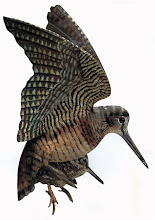Nori:
josebafelix@outlook.es
Gaia: Testimonies from Argos users
Gaia: Testimonies from Argos users
Dear
Joseba,
http://www.argos-system.org/scolopax-rusticola/ (http://www.argos-system.org/fr/becasses-sans-frontieres/ for the French version).
Thanks for everything,
Best
regards,
Vinca
Rosmorduc
Outreach
& training
Environmental
Monitoring
+33
(0)561 394 856
oooooo
Scolopax rusticola without frontiers
09.07.2018 Animal tracking applications
Scolopax rusticola without frontiers
The Eurasian woodcock, Scolopax rusticola, is a very special bird as it is crepuscular. During the day, it rests in places where there is not much light. Thus, this species was not very well known before the first tracking – in 2006, as before that the lightest Argos PPT was 18 g, twice too heavy for a bird around 300 to 350 g.Questions were numerous: What is(are) the real path(s) of Eurasian woodcocks? How long are they flying from the beginning up to their arrival locations? How fast are they flying? Are the Ural Mountains really their destination?…
Track of an Eurasian woodcock (credit Joseba Felix Tobar-Arbulu)
From 2004 onwards, Argos PPTs were made weighing 12 g and soon less (the smallest one is currently 2 g), with solar panels to give them power. This has enabled the tracking of birds as small as the Eurasian woodcock, to the greatest satisfaction and pleasure of people interested by this species, who designed a special harness to attach the Argos PTT to the bird. With the financial help of different institutions (Government of Navarre, of Catalonia, of Bizkaia, of Majorca, … some banks), of the Argos team, plus many people (hunters, field people, …) who helped to locate the birds in many different places around the whole Spanish state, from Galicia to Catalonia, from Andalusia to the Basque Country, so much more of this bird’s behavior is now known.
And as usual, when some of those questions were solved by the tracking, new questions came with the first results, and the study went on, and was also made in other countries — Russia, Scotland, Italy, England, and even the USA for another species, the Scolopax minor.
References:
Joseba Felix Tobar-Arbulu (PhD in Engineering, Prof. of the University of the Basque Country)
(Members of the CCB team: Miguel Minondo, Felipe Diez, Zarbo Ibarrola, Izaskun Ajuriagerra, Rubén Ibáñez, Ibon Telletxea and Joseba Felix Tobar-Arbulu)
oooooo
Bécasses sans frontières
09.07.2018 Oiseaux
Bécasses sans frontières
La bécasse des bois, Scolopax rusticola, est un oiseau très spécial car il vit la nuit. Pendant la journée, il se repose dans des endroits où il n’y a pas beaucoup de lumière. Ainsi, cette espèce n’était pas très bien connue avant le premier suivi – en 2006, car précédemment les balises Argos les plus légères faisaient 18 g, deux fois trop de poids pour un oiseau de 300 à 350 g environ.Les questions que l’on se posait sur cette espèce étaient nombreuses : Quel(s) est(sont) le(s) vrai(s) trajets(s) de la bécasse d’Eurasie ? Combien de temps s’écoule de leur départ jusqu’à leur arrivée ? À quelle vitesse volent-ils ? Les montagnes de l’Oural sont-elles vraiment leur destination finale ?
Suivi d’une bécasse des bois (crédit Joseba Felix Tobar-Arbulu)
À partir de 2004, des émetteurs Argos ont été fabriqués ne pesant que 12 g et bientôt moins (le plus petit pesant actuellement 2 g), avec des panneaux solaires pour leur fournir l’énergie. Cela a permis de suivre des oiseaux aussi petits que la bécasse des bois, à la plus grande satisfaction et au plus grand plaisir des personnes intéressées par cette espèce, qui ont conçu un harnais spécial pour attacher la balise Argos à l’oiseau. Avec l’aide financière de différentes institutions (Gouvernement de Navarre, de Catalogne, de Bizkaia, de Majorque, …. ainsi également que quelques banques), de l’équipe Argos, ainsi que de nombreuses personnes (chasseurs, gens du terrain,….) qui ont aidé à localiser les oiseaux dans de nombreux endroits différents dans toute l’Espagne, de la Galice à la Catalogne, de l’Andalousie au Pays Basque, le comportement de cet oiseau est maintenant beaucoup mieux connu.
Et comme d’habitude, lorsque certaines de ces questions ont été résolues grâce aux suivis, de nouvelles questions sont venues avec les premiers résultats. L’étude continue, et a également été réalisée dans d’autres pays — Russie, Ecosse, Italie, Angleterre, et même les États-Unis pour une autre espèce, le Scolopax minor.
Références:
Joseba Felix Tobar-Arbulu (PhD in Engineering, Prof. of the University of the Basque Country)
(Members of the CCB team: Miguel Minondo, Felipe Diez, Zarbo Ibarrola, Izaskun Ajuriagerra, Rubén Ibáñez, Ibon Telletxea and Joseba Felix Tobar-Arbulu)


